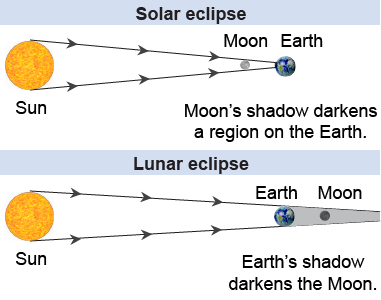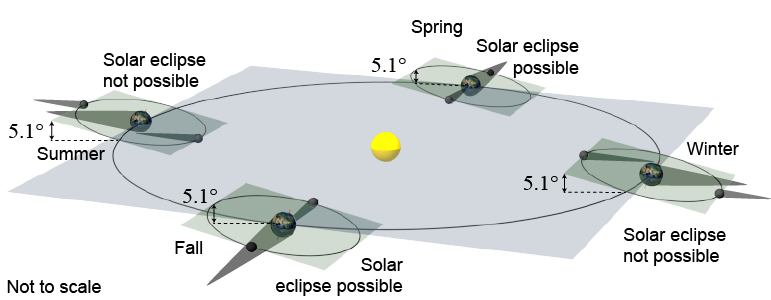|
 If you have ever seen a solar or lunar eclipse, you may have asked this question:
If you have ever seen a solar or lunar eclipse, you may have asked this question:
Why do eclipses occur?
Ancient people certainly asked the question and invented many contradictory answers, usually involving supernatural powers. To answer the question using physics, you need to know the relative positions of the Sun, the Moon, and the Earth, as well as the fact that light travels in straight lines. 
|
Eclipses occur when one celestial body blocks the light coming from another body. In other words, one of them is casting a shadow! When the Moon lines up between the Sun and the Earth, the Moon casts a shadow onto the Earth, blocking the Sun for a small region on the Earth. This creates a solar eclipse in which some or all of the Sun appears to vanish. When the Earth lies between the Sun and the Moon, the Earth’s shadow—which is larger than the Moon’s shadow—engulfs the Moon, blocking sunlight from reaching the Moon. This creates a lunar eclipse in which the Moon appears to vanish. Solar and lunar eclipses do not occur very often because the plane of the Moon’s orbit around the Earth is inclined a little bit relative to the plane of the Earth’s orbit around the Sun. 
 |
 There are two “eclipse seasons” about six months apart. Solar eclipses only occur during the spring and fall, near the equinoxes. They never occur in summer or winter. Why? The Moon orbits the Earth every 27 days. Why doesn’t the Moon block the Sun every month?
There are two “eclipse seasons” about six months apart. Solar eclipses only occur during the spring and fall, near the equinoxes. They never occur in summer or winter. Why? The Moon orbits the Earth every 27 days. Why doesn’t the Moon block the Sun every month?
The answer lies in the tilt of the Moon’s orbit. If the Moon orbited in the plane of the Earth’s orbit, solar eclipses would be monthly events. Instead, the Moon’s orbit is tilted 5.1° from the ecliptic of the Solar System. Only in spring and fall does the Moon pass directly between the Earth and Sun so that its shadow passes over the Earth. In the summer and winter, the shadow of the Moon always falls above or below the Earth’s orbital plane. 
|
Have you ever wondered whether Earth’s shadow creates the crescent Moon? How does that explain the full Moon? Why is the dividing line between light and dark straight instead of curved in a half Moon? Why does the Moon go through these phases? The answer is that a shadow does create the observed phases of the Moon, except that the shadow is not the shadow of Earth but the shadow of the Moon itself. 
|
 Sunlight travels in straight lines toward the Moon, which illuminates the side of the Moon facing the Sun. The Moon orbits around the Earth, which causes the illuminated side of the Moon to change its orientation relative to the Earth. Sometimes, we can see the fully illuminated side of the Moon, which is called a “full Moon.” Other times, the illuminated side is facing completely away from the Earth, which is called a “new Moon.” In between are the other phases of the Moon: crescent, quarter, and gibbous.
Sunlight travels in straight lines toward the Moon, which illuminates the side of the Moon facing the Sun. The Moon orbits around the Earth, which causes the illuminated side of the Moon to change its orientation relative to the Earth. Sometimes, we can see the fully illuminated side of the Moon, which is called a “full Moon.” Other times, the illuminated side is facing completely away from the Earth, which is called a “new Moon.” In between are the other phases of the Moon: crescent, quarter, and gibbous. 
|
Are lunar or solar eclipses more visible on Earth?
 |
Lunar eclipses are visible from more places on the surface of Earth. Solar eclipses are only visible in the small area where the Moon’s shadow covers the Sun, whereas lunar eclipses are visible in the lager area where the Earth’s shadow covers the Moon. 
|
| |
|

